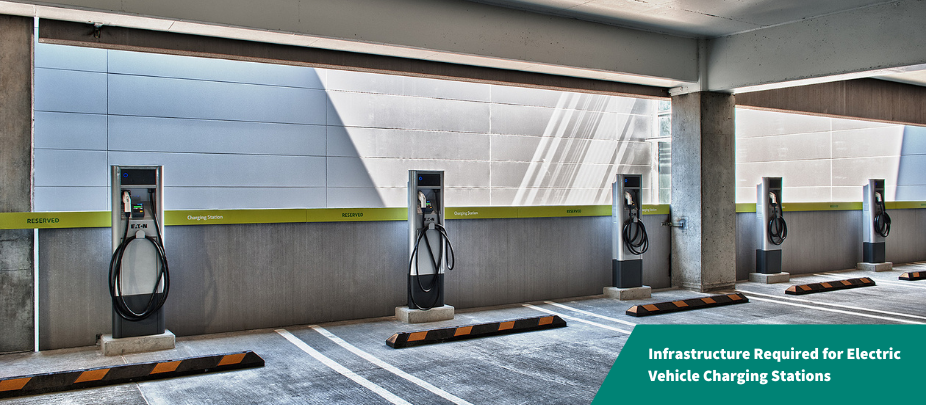Infrastructure Required for Electric Vehicle Charging Stations
By James T. Cicero | Jul 20, 2023

Infrastructure Required for Electric Vehicle Charging Stations
Electric vehicles are more than just chic toys. Many are predicting that by 2030, one in every three cars sold will be electric. One of the reasons behind the increase in demand is the advancements in battery technology and charging technology.
However, as the number of electric vehicles on the roads continues to grow, a question arises: Is the electrical infrastructure of public buildings, apartment complexes, and workplaces prepared to handle the increased load of electric vehicle charging stations?
Types of Electric Vehicle Chargers
There are two types of chargers for electric vehicles: AC chargers and DC fast chargers. AC chargers require the car to have an on-board charging device in the car to convert the AC power to DC power. Whereas DC fast chargers have the AC to DC charging device integrated into the external charging station, eliminating the need for it in the car itself. This external charging device allows for a much larger AC to DC charging capacity. As a result, this technology has significantly reduced the time required to charge electric vehicles.
Categories of Electric Vehicle Chargers
Electric vehicle chargers are categorized into three levels. Level one chargers are designed to be plugged into a standard receptacle in your house. These receptacles are typically connected to a 20 Amp single-pole circuit breaker. According to code, the load on this circuit must not exceed 80% of its capacity. Therefore, the power available for charging the car is limited 1.9KW.
Level two chargers, while still residential grade, are connected to a 240V power source. Most chargers of this type allow for adjustable current draw, based on the circuit breaker capacity or available power at the residence. Assuming the residence has a 50 Amp, two-pole breaker, the charger would be capable of providing 9.6KW of power to charge the battery. This is equivalent to the power requirement of a residential oven.
The table below shows typical level one and level two chargers, such as the ABB Terra AC Wall Box and the JuiceBox 40. The table includes three EV typical battery sizes and the corresponding charging times for each charger. Additionally, the table shows information on the number of miles each charger can charge in one hour and over an 8-hour period. From the “Miles Charged Per Hour” column, these chargers are suitable for longer charge times, but they would not be adequate for charging times less than one hour.

Level three chargers are high-powered chargers designed for non-residential use and require three-phase power. Typically, level three chargers are of the DC fast charging types. The size of these chargers varies depending on the available electrical infrastructure. ABB offers a range of DC fast chargers from 50KW to 180KW in capacity.
The table below shows the charger specifications and corresponding charge times for typical EV batteries listed. As shown in the table, DC fast chargers can add a significant number of miles to an electric vehicle’s range within a matter of minutes, rather than hours.

Infrastructure to Support Electric Vehicle Chargers
Unfortunately, the infrastructure needed to support these DC fast chargers is significant. The chart below shows that the required transformer size at 480 volts with 5, 10 and 15 charging stations of different capacities.

As the table shows, adding just 5 fast charging stations requires an electrical service of 750KVA. To accommodate 10 charging stations, a 1500KVA transformer is required, and 15 charging stations require a 2000KVA transformer. Given the substantial size of the electrical infrastructure needed for these fast chargers, it does not seem feasible that all public or private establishments will be able to install them. Instead, the network of fast charging stations will likely be distributed throughout a region, similar to the distribution of gas stations, with larger institutions supporting such facilities.
Since many drivers primarily use their cars for commuting to work and running errands within their local communities, their daily mileage does not exceed 100 miles. Considering that electric vehicles typically offer battery capacities ranging from 250 to 400 miles per charge, most EV drivers can easily fulfill their charging needs at home. Only when EV drivers plan to go on longer trips will they actively seek out charging stations outside of their home?
Accommodating Increased Adoption of Electric Vehicles
The demand for charging stations will be particularly high among renters who are unable to modify their electrical infrastructure to install a home charger, as well as individuals living in apartment buildings and other multi-family dwellings. These types of residential facilities will likely need a combination of level two chargers for overnight charging and level three DC fast chargers.
Implementing either of these solutions will likely require new electrical infrastructure. However, facilities that choose to install these charging options sooner than later will likely have a competitive advantage as EV adoption increases. Especially for residential property owners, EV chargers can serve as a compelling selling point for potential residents or tenants.
Thinking about installing EV charging stations at your facility? Karpinski Engineering helps property owners and operators evaluate their facility needs to determine the infrastructure requirements for EV charging installation or expansion projects. Contact us today to learn more about installing EV chargers at your facility.